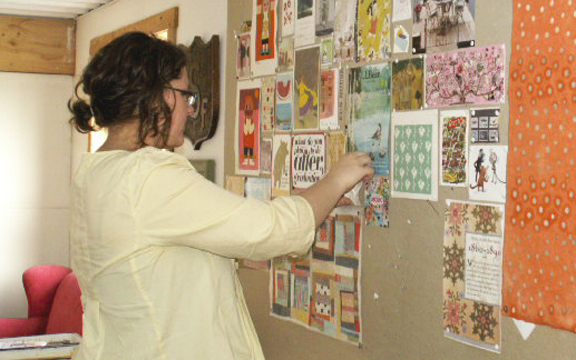A Little Q + A with Patricia Mumau from Primele Studio
New for 2010 and recently unveiled at the National Stationery Show, we are excited to introduce you to the second of our two new calligraphy fonts exclusive to Smock! Calligrapher Patricia Mumau of Primele Studio created our new Harrison font, a bold, fresh calligraphy lettering style that we showcased on our 2010 NYIGF invitations. Patricia worked alongside our internationally recognized typography firm to create her amazing new font and we’re proud to show it off! All of our calligraphy fonts (now four in total) are available with no additional calligraphy fee when you order custom letterpress stationery from Smock. Visit one of our awesome Smock dealers to see samples!
Today it is our pleasure to welcome Patricia to the blog for a little Q + A session. Welcome, Patricia!

How did you become interested in calligraphy?
I was studying in Rome at the time, and I came across a street vendor selling antique mail to collectors – old letters and postcards, amazing postage, meaty papers – and all with the most fascinating handwriting. The penmanship was imperfect but graceful, for everyday and yet lucidly personal. I wanted to capture that candid natural hand in a contemporary calligraphy and began experimenting.
What tools does someone need to start learning calligraphy?
Patience, creative freedom, access to a library, a pen nib and holder, and a bottle of ink in a irresistible color.
What was the process like for designing a font for Smock?
For my part, I created gobs of handwriting samples. I took time to consider the nuances of my mark making – the way I dotted my “i”s, the curve of my question mark…
What do you think makes hand calligraphy so special?
Some projects really need that look of handwritten typography, and having access to handwriting styles on demand with calligraphy fonts makes a great addition to a graphic designer’s toolbox. But however useful, fonts can’t do everything. When it comes to spot phrases that require a bit of artistic flare and incorporated flourishes, hand calligraphy is the better fit.
What was the first lettering style you learned?
Classic American Cursive in 2nd grade. I am glad to have put those “Q”s masquerading as “2”s behind me.
Are you right or left handed?
I’m left handed, which made things interesting at first as I was learning. But with a bit of trial and error I figured out techniques that worked for me.
What’s a normal workday like for you?
#1) Coffee. Next I usually go over what’s on the docket with my sister Rachel who manages the studio’s projects. I do most of my addressing in the late morning and early afternoon, and work on design projects such as invitations in the later part of the day.
Other than invitations, envelopes and place cards, what other fun things do people have hand-lettered?
I’ve created logos, transcribed letters, and designed calling cards. Currently I’ve been creating a lot of hand-lettering for return address stamps.
What is your favorite letter in the alphabet to calligraph?
A capital “Z”, all the way.
What fictional character would you be and why?
Virginia Lee Burton’s Little House. I’d like to think that while the world is constantly changing all around me, that I’d remain true to the builder’s intentions…and maybe someday make a move to a fantastic landscape and get a new coat of paint.
Where do you look for inspiration?
Mid-century picture book illustration, piped birthday cakes, American folk needlework, Swiss graphic design, opening credits to films from the 40’s and 50’s, Swedish decor, happy thoughts.
What is your favorite book of all time?
A Hole is to Dig by Ruth Krauss
How long have you been doing calligraphy professionally?
I started marketing my services late summer of 2009, so a little over a year now.
Primele consists of you and your two sisters, does everyone have a say in the design process?
We all bring our own strengths to the table. For me it’s the hand-drawn typography and illustration. I also tend to work a lot with the initial concepts and designs. Rachel does most of the work once a design is brought into the computer. She’s our Adobe software guru who makes everything graphically perfect. At different times throughout a project we’ll run it through the-kimmy. Kim has an amazing eye and a sensitive design palate, and her perfected taste acts as a kind of editor to my sometimes too-funky ideas.




